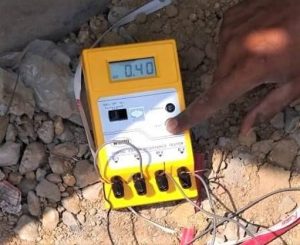Earth Resistance Testing & Monitoring
Earth Resistance Testing & Monitoring
The resistance offered by the earth electrode to the flow of current into the ground is known as the earth resistance or resistance to earth. The resistance of an earth electrode is made up of three components Resistance of the (metal) electrode, Contact resistance between the electrode and soil, and lastly Soil Resistivity. For checking the efficiency of earthing system, the tests done are measurement of earth resistance of each electrode and measurement of resistance of entire earthing system when all electrodes are connected to the grid. These tests shall preferably be done during the summer months.

Earth Resistance Test:
Earth resistance test should be carried out in timely as quarterly basis because with time the lack of moisture the soil resistivity can be increase as above 2 ohm. High resistance is the cause of interruption of current flow in quickly so resistance value should be less then 2 ohm. So in tis way the earth resistance test is required in timely.
The earth electrode resistance value should be less than 2 ohm. For better performance of earth electrode, the value of earth resistance should be minimum if the value is more than 2 ohm then short circuit current will not flow quickly. During fault condition current should be travel quickly into ground through earth electrode. So in this way we can say earth resistance value should be check timely as quarterly basis.
Why is need Earth Ground Testing ?
The measurement of ground resistance for an earth electrode system should be done when the electrode is first installed, and then at periodic intervals thereafter. This ensures that the resistance-to-ground does not increase over time. The International Electrical Testing Association specifies ground electrode testing every three years for a system in good condition with average up-time requirements.

Poor grounding not only increases the risk of equipment failure; it is dangerous too. Facilities need to have adequately grounded electrical systems so in the event of a lightning strike, or utility overvoltage, current will find a safe path to earth. Although the ground system when initially installed had low earth ground resistance values, the resistance of the grounding system can increase if the ground rods are eaten away by corrosive soils with high moisture content, high salt content, and high temperatures.
If our technician finds an increase in resistance of more than 20 percent, we will investigate the source of the problem and make the correction to the grounding system to lower the resistance.
